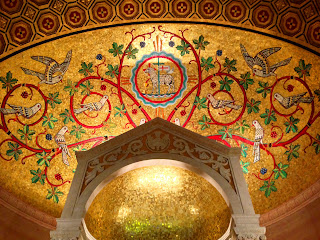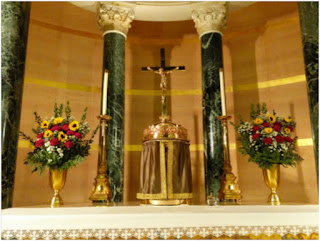Will You Be My Fruitful Branches?
This impressive mosaic fills the
entire top portion of the apse in the Seminary Chapel. Built in 1954, the ornamentation within
the Chapel was added over the years shortly after its completion. Upon entry into this Sacred Space, the
mystical reality of the Heavenly Jerusalem is beautifully laid out with each
piece of tile. From the back doors
of the Chapel, the central architectural theology of the Chapel is centrally
depicted here before anywhere else.
In the 15th chapter of
St. John’s Gospel, we read of the parable of Jesus the True Vine. The apse mosaic incarnates verse 5
where we read, “I am the vine, you
are the branches. Those who abide in me and I in them bear much fruit, because
apart from me you can do nothing.”
From this, the rest of the Chapel takes its meaning.
 The Lamb stands over
five red circles, symbolizing the five wounds suffered on the Cross, which are
visible reminders of His victory, so that through them the chalice might be
filled. His stance is stately and
still, with Blood still flowing, symbolizing that our savior stands ever ready
to be our example, guide, source of strength, and victor over the trials of
earthly life.
The Lamb stands over
five red circles, symbolizing the five wounds suffered on the Cross, which are
visible reminders of His victory, so that through them the chalice might be
filled. His stance is stately and
still, with Blood still flowing, symbolizing that our savior stands ever ready
to be our example, guide, source of strength, and victor over the trials of
earthly life.
The Cross, as the instrument used to
strike the cornerstone for living water to gush forth, waters the True Vine
within which we are called to abide.
All of this speaks to the heavenly Jerusalem envisioned in the first
verses of chapter 22 in Revelation.
If we abide in the vine of Christ, then we participate in the
unification of nations spoken of in Revelation, since the gathering of all
mankind to the bosom of the Father was, is, and will always be the Incarnation
and Paschal Mystery. The last few
details are tied fairly close together.
The vine itself is red, instead of a vine we might consider being green. Within the outstretched crimson arms
are a series of twelve crowns, with twelve doves nesting throughout. The red vine points to the Blood shed
by the Lamb which gives us life.
Living a life connected to Him requires being connected also to His
Death. Therefore, the heavenly
life promised in this mosaic is depicted by the crowns found within the arms of
the vine. The doves, too, are
birds of peace. They point to the
nations mentioned in Revelation, the Tribes of Israel, being healed from
division and gathered together in the peace of Christ.
This mosaic speaks to intimate union with Christ the True
Vine, as well as the requirements and promises to the souls seeking to live a
life united to Him. As St. Paul
reminds us in the second chapter of his Second Letter to Timothy, “If we have died with him, we will also
live with him; if we
endure, we will also reign with him; if we deny him, he
will also deny us; if we are faithless, he remains
faithful – for he cannot deny himself.”
Written by Anthony McFarland, Seminarian for the Diocese of Beaumont, TX







Comments
Post a Comment